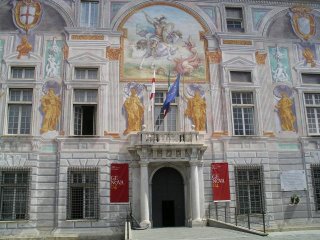James Hamilton (link below) commits an egregious, but all too common, error:
Yet another example, and the one people often think of first, would be if there is a higher inflation rate in the U.S. than Europe. In that case we might expect to see an increase in the price of oil that exactly equals (in percentage terms) the decrease in the value of the dollar...The graph below plots the cumulative logarithmic change since 1999 in the dollar price of one euro along with the dollar price of one barrel of oil...
Hamilton then computes correlation coefficients between dollar oil prices and the euro/dollar exchange rate, finds a number of periods in which they are not closely correlated, and concludes that the dollar does not explain most of the dramatic rise in oil prices. Why do we keep seeing this kind of reasoning from supposed authorities like Mr. Hamilton? The flaw should be quite obvious, but since I've seen it mindlessly and repeatedly perpetrated by a number of professors of economics over the last few months, allow me to tediously correct it: if greater inflation is expected in
both the euro and the dollar, the price of oil will increase in
both euros and dollars. The euro/dollar exchange rate reflects
relative monetary changes between the dollar and the euro, and the monetary component of the dollar oil price reflects
absolute monetary changes in the dollar. It is absurdly illogical to expect the relative and the absolute to be strongly correlated. If the monetary changes in the euro and the dollar are of similar magnitude and direction, oil and gold prices will go up or down for these monetary reasons while the exchange rate changes little for these reasons. If European and U.S. monetary authorities are reacting in similar ways to, for example, similar credit crunches, there is no reason to expect a substantial correlation between euro/dollar exchange rates and oil prices. We will see such correlation for monetary reasons only when they are reacting with substantially different magnitudes or in different directions.
In expectation terms, the euro/dollar exchange rate reflects relative inflation expectations and surprise relative inflation between the dollar and the euro, whereas the monetary component of the dollar oil price reflects absolute inflation expectations and surprise absolute inflation for the dollar.
Analyzing the weekly price quotes since 2000, I get a correlation coefficient of 0.93 between the dollar price of gold and the dollar price of oil -- both absolute measures of dollar inflation expectations and surprise dollar inflation. The alternative hypotheses, changes in expectations and surprises in technological/geological supply or industrial demand, have very different effects on gold and oil that should lead to low correlations between their prices. The high correlation between gold and oil implies that oil as well as gold price changes are dominated by monetary factors. Many professional economists seem to be in denial about these basics of life under fiat currencies, perhaps since this ruins using the highly visible gas prices for simple chapter 1 lessons about how the fundamentals of consumption demand and supply by themselves are supposed to fully determine prices. These chapter 1 exercises, besides neglecting expectations, assume fixed-value currencies, and spectacularly fail for mineral commodities in our world of fiat currencies. In that world there is a monetary component to mineral commodity prices exponential in size to the expected inflation rate. This monetary component always dominates the gold price and at more than minimal levels of expected inflation (i.e. > ~2%/year) it also dominates oil prices, as demonstrated by the high correlation between gold and oil prices since 2000.
[UPDATE: another thing that puzzles many economists is why oil consumption has not dramatically slackened, and indeed in some areas has still risen, in response to climbing oil prices. This demand puzzle is a problem for any theory, whether monetary or fundamental. The answer involves demand fundamentals, but does
not involve fundamentals that have
changed substantially in the last decade: demand forms a fairly constant backdrop for the monetarily-driven dramatic rise in oil prices; it does not itself explain the rise. The answer to the demand puzzle is that despite all the recent political sci-fi rhetoric to the contrary, oil is a superior form of energy, often with no economical ready substitutes, as well as a great chemical feedstock. Automobiles in particular give us quite valuable
real options that the vast majority of us actively seek and are extremely reluctant to give up. When gas prices go up we cut back on luxuries and many other kinds of necessities to make room for greater gas expenditures. Alternatives are typically costly status items, like hybrids, that are not practical substitutes for most people. As a result the demand for oil is far less elastic than for most commodities. Furthermore, because the dramatic oil price rise of the last decade is largely a monetary not a fundamental effect, the costs of alternative energies and conservation are also inflating -- they are simply much stickier than oil prices and will thus lag but eventually catch up to them. Investments in them will turn out far worse than a mere fundamental analysis would indicate, and enough people remember the 1970s, and how tacky and dangerous the small cars everybody bought in the late 1970s and early 1980s seemed by the late 1980s, that this has made people more reluctant to buy small or alternative in the current runup. Adding to oil's inelasticity are the many countries that subsidize fuel consumption.
Observe that this inelasticity and these subsidies, while important for explaining the demand puzzle, have not changed substantially as dollar oil prices have climbed by more than a factor of 10 since 1998. The component of the demand curve reflecting fundamentals has gradually risen, but it has also risen by a similar proportion in many prior decades and can't explain any dramatic increase in oil prices. What has changed are inflation expectations, driven by increasing government deficits and expected central bank behavior in response to the credit crunch, among other monetary factors. Our higher oil and gold prices reflect, exponentially, the increase in these expectations.]
(Here's the
link to Hamilton's erroneous analysis, H/T Marginal Revolution, and my comments above were originally made at that blog, and appear here slightly edited).
Here are two graphs I've recently made based on my historical studies of the relationships between inflation, long-term inflation expectations, gold, and oil (click to enlarge):

The first graph shows implied expected inflation based on historical weekly gold and oil prices, 2000-2008. The oil and gold prices are adjusted for an estimate of historical inflation (specifically inflation as measured by CPU-I up to the date of the price, as opposed to inflation expected after the date of the price, which these adjusted prices imply) and for a small fundamental long-term trend (see below). The absolute expected inflation is based on certain baseline assumptions, whereas the relative changes in inflation expectations are not based on these parameters but simply on the theory that the oil and gold prices reflect the net present value of expected inflation, which is an
exponential function. There is a close correlation, specifically 0.93, between the weekly movements of gold and oil prices in this period. The expectations implied by oil include both monetary component reflected by this correlation as well as a much smaller component primarily reflecting differing expectations and surprises between gold and oil in industrial demand and technologicaly/geological supply.
The separate oil (in gold prices) expectation graph reflects this difference. My attribution of all the differences between gold and oil to these fundamentals assumes that there has been insignificant change in the relative demand for gold and oil
as money, which may be dubious assumption give the great recent rise in the use of oil and other commodity derivatives to hedge inflation in investment portfolios, and also the possibility that the security of economic property rights (i.e. effective long-term control by the same entity) in oil has increased recently faster than that of gold. But the fundamental contribution to the price of oil in terms of gold must be substantial since the graph of the difference in price expectations between the two reflects major events impacting oil demand such as 9/11(which along with the recession from the dot-com crash greatly impacted world and especially U.S. travel, reducing oil demand).
A few potentially important monetary events, such as the appointment of Ben Bernanke to replace Alan Greenspan as Fed chairman, are also labeled. There is a significant increase in the both the level and volatility of inflation expectations around and after this appointment as the market tried to predict how inflationary Fed policy under Bernanke might become, and generally indicated that higher inflation could be expected from Bernanke than Greenspan. Even before Bernanke was chosen, the ballooning federal deficits after 9/11 caused a gradual but substantial increase in inflation expectations from then until the end of Greenspan's term. Over his entire leadership from 1987 to 2006, Greenspan lowered inflation expectations from about 4% to below 2%, and they then rose to about 2 1/2% by the end of Greenspan's term, and are back above 4% today. (Greenspan in his own book,
The Age of Turbulence, published in 2007, says that with fiat currencies we can expect inflation of about 4.5% from here on out, a more pessimistic estimate than that probably implied by gold prices in 2007, but perhaps a bit more prescient than the market given that inflation expectations have increased to above 4% in 2008. Of course, remember that my model reflects changes in inflation expectations much better than absolute inflation expectations, so these absolute numbers are very approximate).
Not shown on these graphs is a very interesting possible difference of nearly 1% between inflation expectations implied by gold, recently a bit over 4%, and expectations implied by TIPS (U.S. Treasury bonds with returns adjusted by the U.S. CPU-I inflation index), recently 3.3% The difference may largely reflect the errors I have suggested might exist in my absolute (but not relative) numbers due to my choices of parameters, but they might also reflect one or more of the following:
(1) The difference between the consumption basket of the U.S. urban consumer (as reflected in the CPU-I) and a global consumption basket;
(2) Understatement of actual subjectively experienced inflation by the CPU-I formual based on errors in its formula, perhaps including the "hedonic" and other adjustments made to it in recent years (we don't have TIPS prices to measure differences in gold- and TIPS-implied inflation prior to 2005);
(3) subtleties involving discount rate and utility curve differences between the U.S. urban consumer and some global average; and/or
(4) Prices on the 10-year TIPS reflect inflation expectations only over the next 10 years, whereas gold reflects inflation expectations over an indefinetely long period. If some event (e.g. the baby boomers reaching years of requiring peak medical attention, causing U.S. government deficits to skyrocket) posing great inflation risks is expected to occur within a foreseeable period of time but not within the next 10 years, this could be reflected in a spread between the two implied expectations.
There is also a small component of long-term relative oil/gold fundamentals in my analysis. Since the 1950s, oil prices have increased on average 0.9%/year faster than gold, which I have attributed to a fundamental difference between the two: a greater proportion of oil is actually consumed every year than gold, and so oil is gradually (i.e. at 0.9%/year) becoming scarcer relative to demand than gold. The graphs and implied inflations are adjusted for this effect. This is as close the numbers attribute any reality to "peak oil" theories: they show that we do not face an imminent demise of the oil economy, only a very long and very gradual increase in the technological/geological scarcity relative to consumption demand for oil. Extrapolating the same rate as the last 50 years, the price of oil in terms of gold will take 80 years to double. Taking out monetary factors and this gradual effect, we have had in the recent years (indeed since 1999, although until about 2003 this was masked by low inflation expectations) a small acute crisis in the fundamentals of oil, rising a bit above the 0.9%/year trend as it did in the 1970s, but this burp not substantially greater than in many former years such as in the 1970s, and I expect it, as occured in the 1980s, to reverse from technological substitutes for and conservation of oil which we are currently (as in the late 1970s and early 1980s) overinvesting in, due to monetary effects on oil prices being mistaken for fundamental ones. This mistake will reify as alternative energies and conservation techniques (barring unexpected technological breakthroughs), with stickier prices lagging those of oil in reflecting inflation expectations, increase in price
faster than oil in the next decade (assuming no further monetary problems that further increase inflation expectations and thus oil prices). Prices besides oil, gold, and to a lesser extend other mineral commodities are far stickier than those mineral prices. Once inflation expectations increase, it takes many years for other prices (and especially the stickiest prices of all, wages) to catch up to oil and gold: these other prices greatly lag both increases and decreases in oil and gold prices, and indeed may never catch up at all if the expectations turn out to be wrong (as they indeed often are, given how little information the market actually has on future U.S. government and Fed behavior!)

The second graph shows this expected versus the actual (or at least CPI-U) dollar inflation from 1968 to today. Again from the difference between oil and gold we can see some oil fundamentals such as the impact of the Asian/Russian crisis on lowering oil prices (in terms of gold as well as, in this case, dollars, as inflation expectations were also at their lowest) in 1998 and of the Iran/Iraq war which depressed oil prices in terms of gold in the 1980s (probably due to decreased security of long-term economic property rights in their oil and the need by these oil states to fund their war with limited ability to borrow).
Since I generated these graphs three weeks ago, there has been a substantial and as usual correlated drop in both dollar gold and oil prices, probably reflecting an easing of the credit crunch in the U.S. and more confidence that the Fed, seeing its inflationary behavior lead to immediate and politically consequential pain at the gas pump, is less likely to use high inflation to default on current U.S. debts than was thought in previous weeks. At the same time the overt default risk for Treasuries has nearly tripled, also reflecting some new
political limits on inflationary default. By the way, in the most recent week the dollar also strengthened against the euro by a similar amount, so that the explanation for last week, but not most of the previous ones, involves a monetary improvement unique to the dollar rather than shared by the Fed and the ECB.

[UPDATE: here's a third graph showing implied inflation expectations derived from monthly quotes of gold and oil in dollars going back to 1974, using some different parameters than were used for the second graph econd graph. The two expectations have a correlation coefficient of 0.76. (I forgot to run the correlation with the parameters that generated the second graph, so I wanted to show the graph corresponding to the 0.76). This is still a strong correlation consistent with the long-term trends in oil and gold prices each reflecting a common estimate of future inflation -- gold and oil fundamentals are very different and so cannot lead to such strong correlation. This compared to two random walks with no long-term tendency to rise, which on average have no correlation.
Per the comments below, the 0.93 coefficient cited above might for statistical reasons suggest much more correlation than actually there due to the rising nature of both making the differences from the mean calculated in the coefficient consistently large and thus reducing the proportional difference in movements: a random walk that tends to rise can also have correlation coefficients in the .60's to .90's. Indeed taking correlations of differences we get only .25, on the high end of weak positive correlations, for one-week deltas, but this rises with the weeks of difference: I've calculated up to 40 week deltas which give 0.64, a strong correlation. This suggests that weekly fluctuations are dominated more by non-monetary factors and the monetary factors don't start to dominate until the price movements are over about 6 months: fundamental fluctuations tend to be shorter term and tend (except for the 0.9% secular trend for which I've adjusted the data) cancel each other out. There are also as I undestand it, and I am admittedly no statistical expert, statistical reasons to expect that the 0.25 is too low in that such differencing can exagerate noise. For the two implied inflation expectations in the third graph, which have a 0.76 correlation coefficient, the exageratedly small differences in proportion due to large distances from the mean should be greatly reduced since the series is largely flat, finishing pretty much where it started. But all this must be subject to review by people far more knowledge in statistics than I. :-) ]







 Flag with traditional English symbols: gryphons and cross of St. George. More importantly, England borrowed and improved upon many Genovese commercial innovations, ushering in the modern era of global trade and the industrial revolution.
Flag with traditional English symbols: gryphons and cross of St. George. More importantly, England borrowed and improved upon many Genovese commercial innovations, ushering in the modern era of global trade and the industrial revolution.

